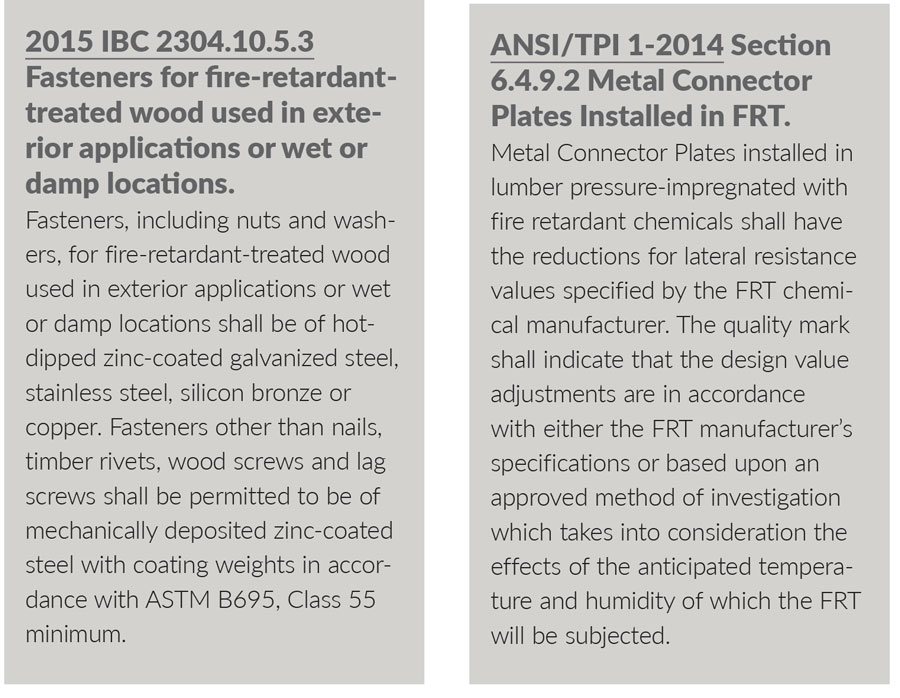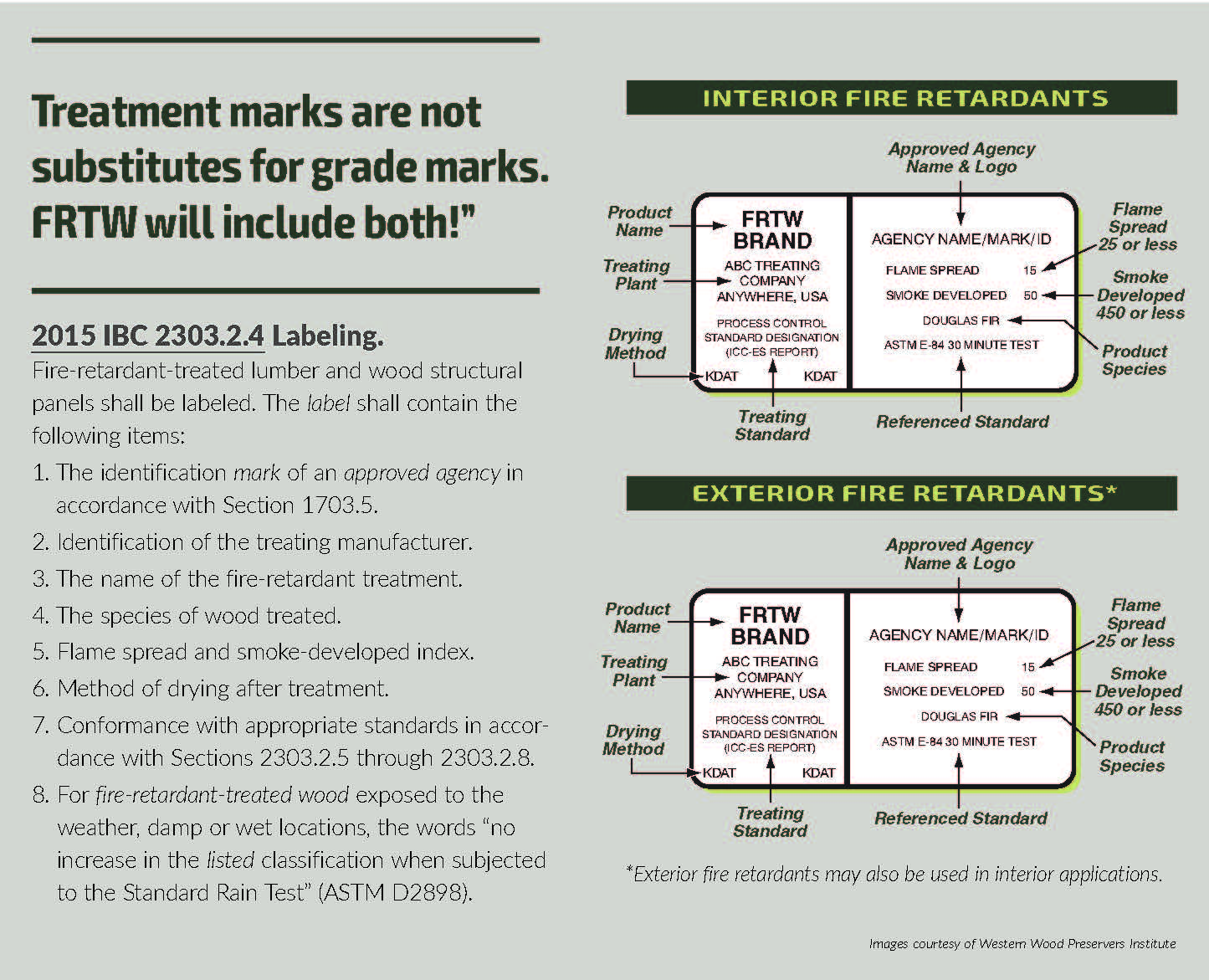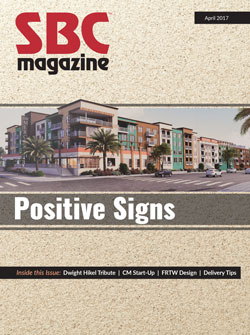A Designer’s Guide to FRTW
A Designer’s Guide to FRTW
Metal plate connected wood trusses are sometimes used in applications or environments that require the trusses to be designed and constructed with chemically treated lumber. The two most common types of chemically treated wood used in trusses are preservative treated wood (PTW) and fire retardant treated wood (FRTW).
Chemicals and treatment processes can require reductions in the strength and stiffness design properties of the wood or the lateral resistance strength (i.e., grip) of the connector plates. They can also require additional corrosion protection for the connector plates.
The building designer is responsible for specifying any type of wood treatment to be used. Section 2.3.2.4(g)(6)(iii) of ANSI/TPI 1-2014 requires construction documents include information concerning moisture, corrosive chemicals and gases expected to result in corrosion potential from wood treatments or other sources that can be detrimental to trusses.
Still, truss design technicians need a basic understanding of the potential effects the various treatments can have on the lumber and connector plate properties so appropriate adjustments can be made during the design process to ensure the trusses perform as intended by the building designer.
Building codes allow fire retardant treated wood (FRTW) to be used in certain applications where noncombustible materials are otherwise required. Truss technicians encountering this situation should know to check with the treatment supplier, the truss design engineer and the connector plate supplier to determine the appropriate adjustments to make to the wood and plate strength values as well as the type of corrosion protection to use on the connector plates.
Fire retardant treatment does not make wood “noncombustible,” as defined by the building codes, but it does reduce the wood’s ability to contribute to flame spread and the subsequent growth of a fire. A key distinction here is that the focus is on reduced flame spread. Non-combustion is not the same as fire endurance, a performance capacity determined by an ASTM E119 fire endurance assembly test. FRTW does not improve the performance or the fire endurance rating of lumber. Similarly, the ASTM E84 (UL 723) test method that is used to classify the fire performance and smoke development of interior wall and ceiling finishes should not be confused with FRTW.

Only materials that meet the criteria established in Section 2303.2 of the 2015 International Building Code are considered FRTW. The reference in the code to “other means during manufacture” indicates that composite products, where the fire retardant chemical is mixed with the wood fiber during the manufacturing process, are acceptable alternatives to FRTW. There are also other products on the market that are approved alternative materials and that can replace FRTW in some applications. These alternate products, even if they’re not pressure permeated or similarly processed, still perform to the level required by the code and can be used interchangeably with the FRTW lumber.
For any product, a truss designer should consult the code evaluation report provided by the fire retardant treatment manufacturer for specific details. All fire retardant treatments applied through pressure treatment processes require a reduction in lumber strength and connector plate grip values due to the type of treatment, the re-drying procedures and the anticipated temperature and humidity to which the FRTW will be subjected once installed. The magnitude of these reductions vary by the fire retardant system used and must be provided by the FRTW treatment supplier. Alternative materials that are approved for use as FRTW may not require a reduction in lumber strength and connector plate grip values. Again, truss designers should refer to the manufacturer’s technical evaluation report (that is, the ANSI ISO/IEC 17065 report), which should explicitly state whether any reductions are necessary.
Conveniently, most of the common brands of fire retardant systems (for example, D-Blaze®, Dricon®, FirePro® and Pyro-Guard®) are not corrosive to the connector plates and allow the use of the typical G60 galvanized metal connector plates used in interior, protected and conditioned environments.
 Finally, truss designers should be aware that if FRTW is to be used where it will be exposed to precipitation, direct wetting, regular condensation or in an unvented roof, it must meet the weathering test requirements of ASTM D2898 and be identified on the FRTW label with the words “No increase in the listed classification when subjected to the Standard Rain Test” (ASTM D2898).
Finally, truss designers should be aware that if FRTW is to be used where it will be exposed to precipitation, direct wetting, regular condensation or in an unvented roof, it must meet the weathering test requirements of ASTM D2898 and be identified on the FRTW label with the words “No increase in the listed classification when subjected to the Standard Rain Test” (ASTM D2898).
Truss manufacturers should use only FRTW bearing a label of an approved agency providing re-inspection services. The label indicates the material has been produced under supervision of an independent inspection agency, and it confirms that the FRTW conforms to the minimum requirements of the building code. The FRTW label must be distinct from the grade mark. The grade mark provides information about the properties of the wood before treating, whereas the FRTW label provides information about the properties of the wood after treating.

Checklist for Designing with FRTW:
- Contact the truss design engineer and metal connector plate supplier to discuss the truss application and treatment being specified before bidding the job. The engineer and supplier can determine the appropriate design criteria and connector plate type to use for the trusses.
- If the project specifications require the use of a specific treatment, consult with the customer and the building designer for review and approval of any treatment substitution.
- Apply the appropriate adjustments to the design properties of the lumber and connector plates to account for the type of treatment and design conditions. Typically, this means selecting the appropriate treated lumber from the materials inventory in your design software, which already includes the strength reductions. It can also mean designing with untreated lumber and adjusting the lumber and plate grip load duration factors. The truss design engineer can determine the best procedure to follow.
- Obtain a copy of the warranty from the FRT chemical manufacturer to verify there are no additional limitations on the product for the application in which it will be used. If there are limitations, rely on your legal counsel (or contact SBCA) for help assessing whether your own customer warranty needs revisions to reflect those limitations.
- Provide the material safety data sheets (MSDS) for the treated lumber with the truss shipment.

